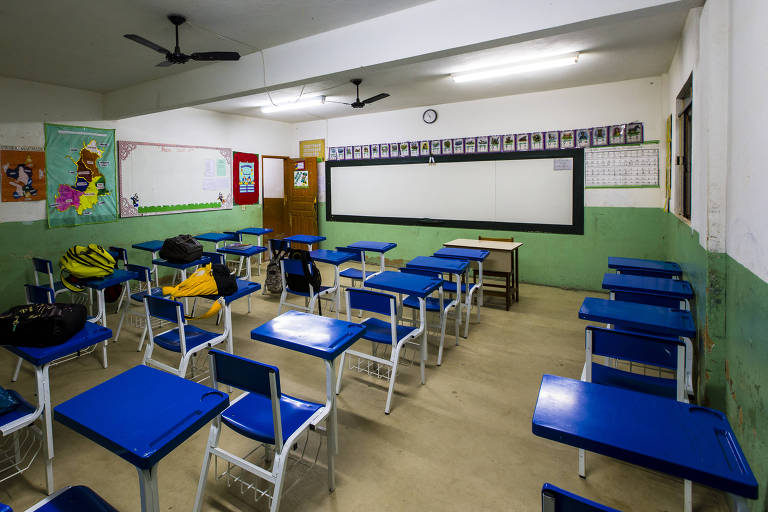Novo índice do Banco Mundial situa país na 81ª posição, atrás da Rússia e da China
Érica Fraga
SÃO PAULO
A baixa qualidade da educação condena as crianças nascidas hoje no Brasil a atingir, em média, aos 18 anos pouco mais da metade do seu potencial produtivo, limitando suas condições de inserção no mercado de trabalho.
É o que revela um novo índice criado pelo Banco Mundial para mensurar os retornos dos investimentos dos países em capital humano.
O resultado do Brasil o situa apenas na 81ª posição em um ranking de 157 nações ordenadas de acordo com o indicador, que será apresentado pela primeira vez nesta quinta-feira (11) durante reunião anual conjunta entre o Banco Mundial e o FMI (Fundo Monetário Internacional), na Indonésia.

Atrás do registrado por oito vizinhos latino-americanos, como Chile, México e Argentina, e de outros países emergentes, como China, Rússia e Turquia, o desempenho brasileiro se aproxima do de nações ou territórios como Cisjordânia e Faixa de Gaza, Filipinas e Kosovo.
Segundo Jaime Saavedra, diretor de práticas mundiais de educação do Banco Mundial, diagnósticos sobre a situação econômica dos países ainda tendem a focar excessivamente indicadores como a situação fiscal e o nível de investimentos em máquina e investimentos.
A divulgação do novo índice na reunião dos dois organismos multilaterais busca alertar os governos para o fato de que investimentos em capital humano também são decisivos para o crescimento econômico.
"Decidimos apresentar o índice nesse encontro que reúne principalmente ministros das Finanças para mostrar que saúde e educação não são problemas apenas dos ministros dessas duas áreas e precisam ser enfrentados de forma mais integrada", afirma o diretor do organismo multilateral.
O novo indicador parte da ideia de que crianças que crescem com acesso a boas condições de saúde e educação tendem a atingir um melhor desenvolvimento físico, cognitivo e emocional, chegando mais preparados ao mercado de trabalho.
Por isso, o índice de capital humano considera três fatores principais: a mortalidade até os cinco anos de idade; resultados educacionais; e condições de saúde na infância e na vida adulta.
Os dados dos países nessas áreas são convertidos em um índice que pode variar de 0 a 1. Quanto mais próximo de 1, melhor o desempenho.
O nível atingido pelo Brasil nessa escala foi 0,56. Isso significa que crianças nascidas hoje no país atingirão aos 18 anos, em média, 56% da capacidade produtiva que desenvolveriam se tivessem recebido as melhores condições possíveis de educação e saúde.
Embora o indicador esteja sendo divulgado agora pela primeira vez, com referência a 2017, o Banco Mundial calculou os resultados a partir de 2012. Essa série revela uma estagnação do índice brasileiro em todo o período.
Entre os aspectos captados pelo indicador, o que representa a maior barreira ao progresso do país rumo a um nível maior de capital humano é a deficiência educacional.
Crianças brasileiras nascidas atualmente deverão atingir, em média, 11,7 anos de escolaridade, de acordo com o Banco Mundial.
Embora o Brasil tenha avançado muito na tarefa de inclusão escolar, o indicador do país ainda fica bem atrás do alcançado por potências educacionais como Singapura (13,9 anos) e Coreia do Sul (13,6 anos), primeiro e segundo colocados no ranking de capital humano, respectivamente.
Essa distância se acentua quando o tempo de escolaridade é ajustado pela qualidade do ensino, mensurado em testes de proficiência internacional.
O baixo desempenho brasileiro nesses exames tem o efeito de subtrair 4,1 anos da escolaridade esperada das crianças no futuro.
No relatório que apresenta o índice de capital humano, o Banco Mundial ressalta que escolheu focar o potencial de desenvolvimento das próximas gerações para enfatizar que a melhora no desempenho dos países dependerá de políticas adotada agora.
Iniciativas nessa direção têm sido impulsionadas por estudos como o do americano James Heckman, ganhador do Prêmio Nobel de Economia, que mostram que o retorno futuro do investimento na chamada primeira infância —que vai de 0 a 6 anos— é enorme.
